RELG 433 - Biblical Archaeology
Palaeolithic, Mesolithic, and Neolithic Periods in the Holy Land
Images in the text are linked to larger photos - click on them to see the larger pictures.
Hover the mouse over the images to see their captions and copyright credits.
The names for these periods all derive from the Greek word "lithos" - a stone - and refer to the material used for tools. Effective ways of producing and working metal had not yet been invented, so cutting, grinding, chopping all had to be done with stone, bone, or wood implements. "Palaeo-" means "old", "Meso-" means "middle" or "between", "Neo-" means "new".
Originally these were all thought of together as the "Stone Age", but it became apparent that there were various developments during the periods which enable archaeologists to classify and date a culture more precisely.
The Palaeolithic period is characterized by simple bands of hunters. They did not know how to grow crops or raise livestock, nor did they build houses. Shelters of skins laid over bones may have been used, but mainly the people were cave-dwellers or wandering groups of hunters.
 Their implements included "hand axes" - stones which had been chipped to give a rounded base suitable for holding in the hand, then tapering to a point which could be used for pounding and chopping, also smaller stone scrapers for skinning animals and preparing hides, and bone awls - pointed needles without eyes which could punch holes in a hide so that it could be laced together into some sort of garment. During this period, spearheads were made from chipped stones, with grooves so that they could be fastened to a wooden shaft.
Their implements included "hand axes" - stones which had been chipped to give a rounded base suitable for holding in the hand, then tapering to a point which could be used for pounding and chopping, also smaller stone scrapers for skinning animals and preparing hides, and bone awls - pointed needles without eyes which could punch holes in a hide so that it could be laced together into some sort of garment. During this period, spearheads were made from chipped stones, with grooves so that they could be fastened to a wooden shaft.
People had already learned to work together, and societies were probably beginning to develop, in which different people had different functions - hunters; flint, stone or bone workers; those who tended the fire and the children.
The Mesolithic period, roughly dated 10,000 BC to between 6,000 and 4,000 BC :
Towards the end of the Palaeolithic, the earth's climate gradually became warmer, the Ice Ages ended, glaciers retreated and melted, and some of the cold-weather animals such as the woolly mammoth died out. Men developed tools and weapons made of "microliths" - small chips and flakes of sharp stone or flint which could be set into a piece of wood or bone to give a cutting implement, or which could be used as arrow points.
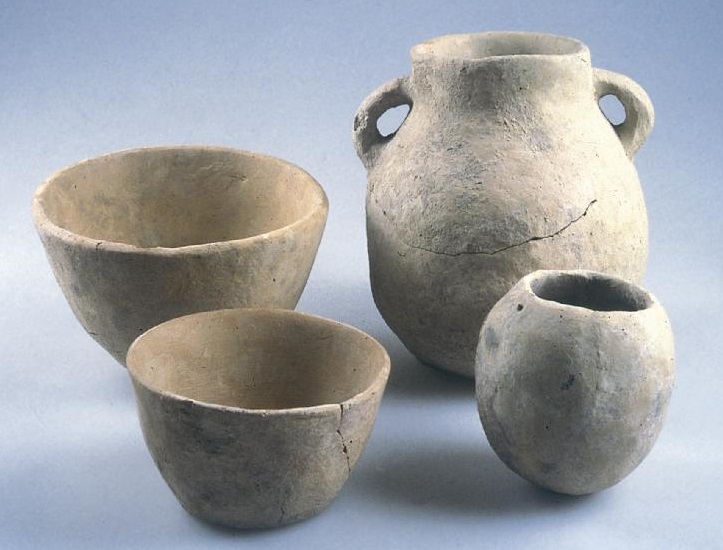 The Neolithic period is characterized by the development of agriculture, the domestication of animals, settlements or semi-permanent dwellings, and eventually the invention of pottery. The stone tools were often made by grinding and polishing, rather than by chipping flakes. These developments took place at different times in different places.
The Neolithic period is characterized by the development of agriculture, the domestication of animals, settlements or semi-permanent dwellings, and eventually the invention of pottery. The stone tools were often made by grinding and polishing, rather than by chipping flakes. These developments took place at different times in different places.
In the Middle East, Neolithic cultures started to develop at around 8,000 BC.

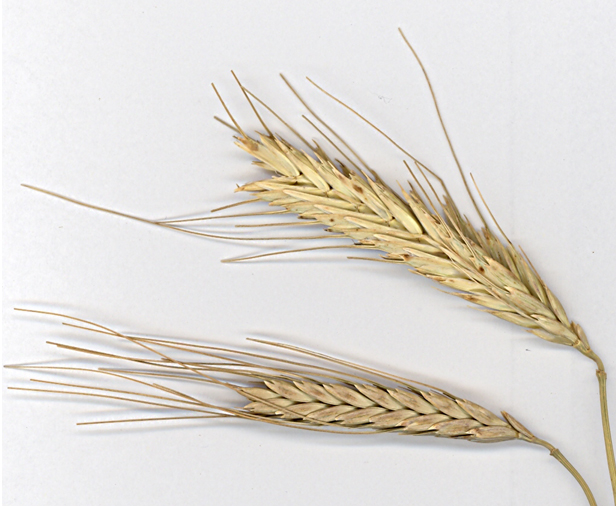 A key to the development of the Neolithic period is the harvesting and cultivation of plants as crops - particularly grain, which could be stored, ground to flour, and cooked. The forerunner of domesticated wheat appears to be "emmer" or "einkorn" - which still grows wild in the Middle East. In order to grow a crop and harvest it, people must settle in a region, at least long enough for the plants to grow and come to harvest.
A key to the development of the Neolithic period is the harvesting and cultivation of plants as crops - particularly grain, which could be stored, ground to flour, and cooked. The forerunner of domesticated wheat appears to be "emmer" or "einkorn" - which still grows wild in the Middle East. In order to grow a crop and harvest it, people must settle in a region, at least long enough for the plants to grow and come to harvest.
Archaeological Sites in Israel and Jordan
12,000 BC
-

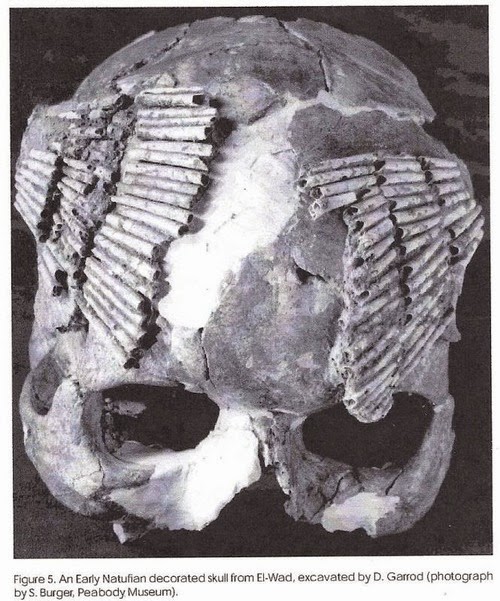
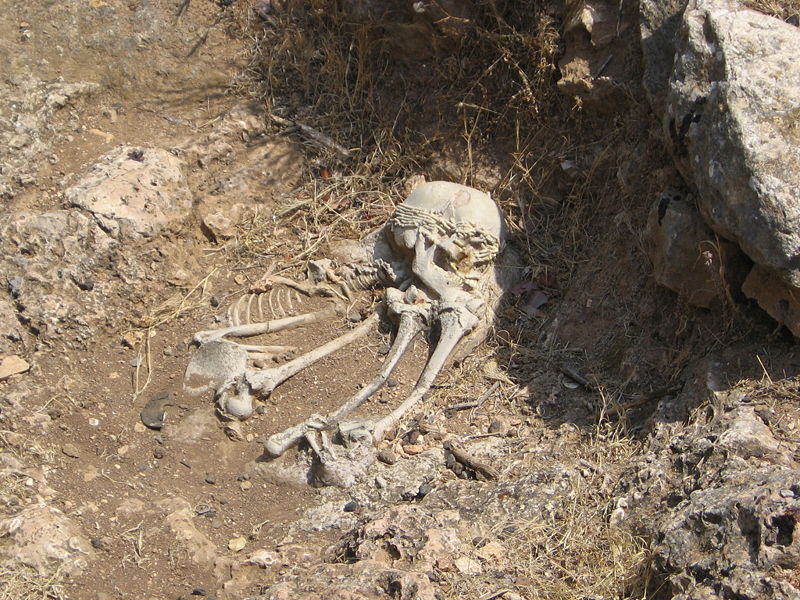
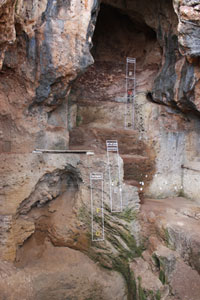
 Wadi Natuf - Carmel Caves, Israel - mainly hunting and fishing, but also evidence for harvesting grain with microlith sickles. The grain may have been cultivated, or the people may have been cutting wild grain. The dead were buried under the floors of the caves where the people lived, and they were buried with grave-goods such as necklaces of shell and bone. This culture was named "Natufian"
Wadi Natuf - Carmel Caves, Israel - mainly hunting and fishing, but also evidence for harvesting grain with microlith sickles. The grain may have been cultivated, or the people may have been cutting wild grain. The dead were buried under the floors of the caves where the people lived, and they were buried with grave-goods such as necklaces of shell and bone. This culture was named "Natufian"
8,500 - 7,500 BC - Pre-Pottery Neolithic A (PPNA)
- Jericho is situated on the West bank of the Jordan river, commanding one of the east-west routes across the river. It has a constant supply of fresh water from a spring which flows from the mountains to the west, and which is still flowing even today. Jericho can claim to be probably the first "city".
There is some evidence that Palaeolithic hunters camped by the spring (a Paleolithic hand-ax was found amongst the Neolithic layers there).
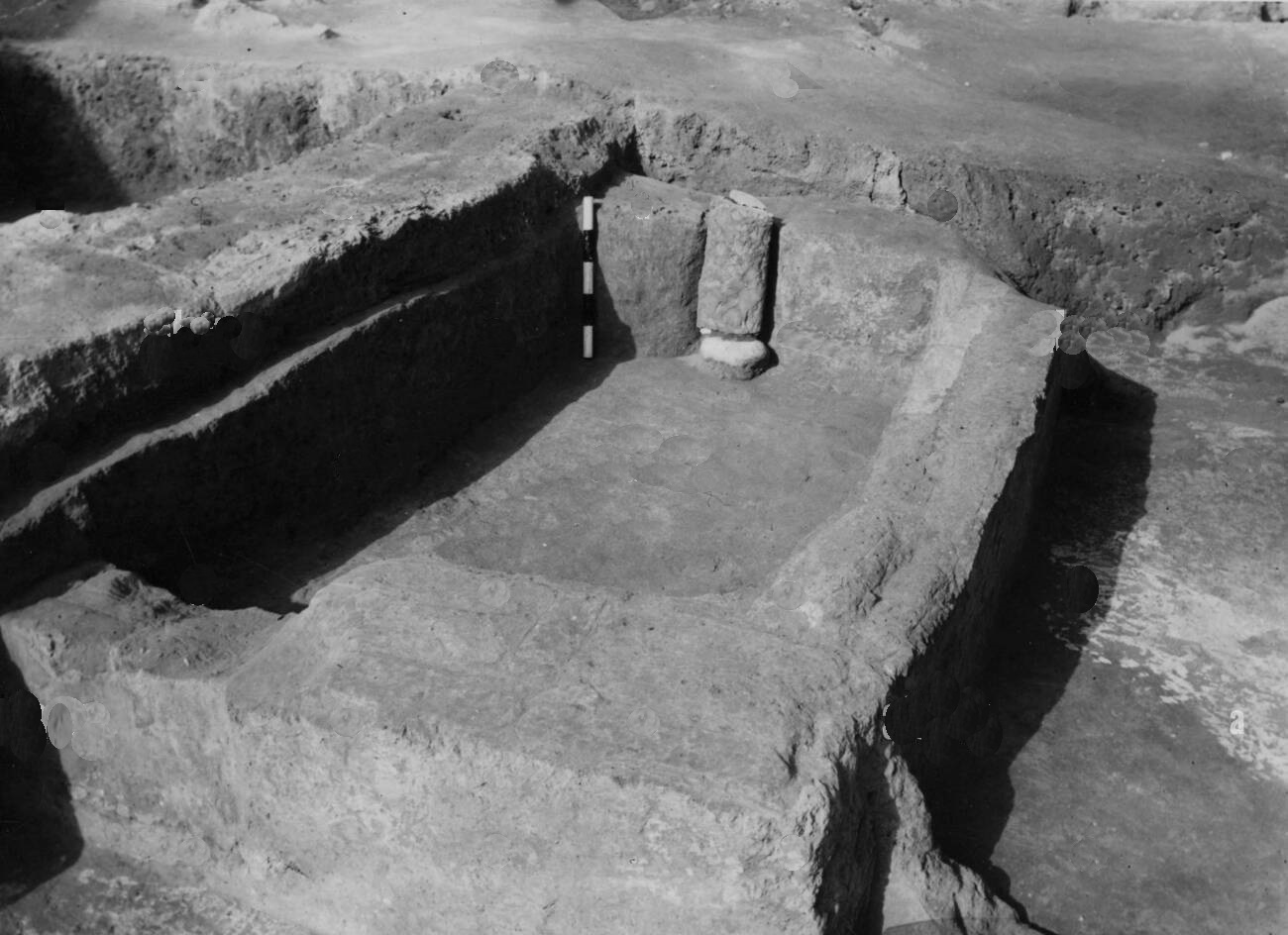 A structure which may be the remains of a Mesolithic shrine contained three large stone blocks, two of which had had holes bored through them; the floor of the building had a cleared clay floor. Amongst the debris associated with the structure were typical Natufian objects, including a bone harpoon head (Carmel is near the Mediterranean Sea, Jericho is not.) Kathleen Kenyon, who excavated and reported these findings, concluded that this was a shrine used by hunter-gatherers allied to the people of the Natufian culture of the Carmel caves. The "shrine" was destroyed by fire; evidently it had had wood beams or branches as part of its construction, because the area was covered by charcoal. Carbon dating of the charcoal gives a range of possible dates, from 7,800 BC ±210 to 9,687 BC ±103
A structure which may be the remains of a Mesolithic shrine contained three large stone blocks, two of which had had holes bored through them; the floor of the building had a cleared clay floor. Amongst the debris associated with the structure were typical Natufian objects, including a bone harpoon head (Carmel is near the Mediterranean Sea, Jericho is not.) Kathleen Kenyon, who excavated and reported these findings, concluded that this was a shrine used by hunter-gatherers allied to the people of the Natufian culture of the Carmel caves. The "shrine" was destroyed by fire; evidently it had had wood beams or branches as part of its construction, because the area was covered by charcoal. Carbon dating of the charcoal gives a range of possible dates, from 7,800 BC ±210 to 9,687 BC ±103
Between bedrock and the Neolithic layers there was a layer, at one place 13 feet deep, of what Dr. Kenyon identified as the floors of hut-like structures, built one on top of another for a considerable length of time, probably by successive generations of nomadic hunter-gatherers who were starting to experiment with agriculture.
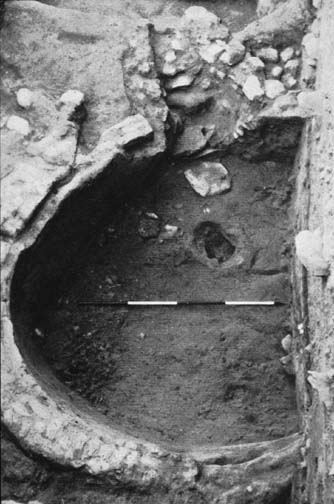 The first identifiable house-structures were round, probably consisting of a pit or low wall with a domed roof of branches, hide, or sod. This marks the transition from Palaeolithic to Neolithic, and a more settled occupation of the site. Each "house" had a porch with steps or a slope down to the house floor from the higher ground outside - the house floor was at a lower level than the outside. The walls of the houses were built with hand-made bricks which were slightly curved on top like a loaf of bread. These early Neolithic houses covered a much larger area of the site than the earlier settlement of huts - evidently the town had began to grow and the population was increasing. This level is characterized as PPNA - "Pre-Pottery Neolithic A"
The first identifiable house-structures were round, probably consisting of a pit or low wall with a domed roof of branches, hide, or sod. This marks the transition from Palaeolithic to Neolithic, and a more settled occupation of the site. Each "house" had a porch with steps or a slope down to the house floor from the higher ground outside - the house floor was at a lower level than the outside. The walls of the houses were built with hand-made bricks which were slightly curved on top like a loaf of bread. These early Neolithic houses covered a much larger area of the site than the earlier settlement of huts - evidently the town had began to grow and the population was increasing. This level is characterized as PPNA - "Pre-Pottery Neolithic A"
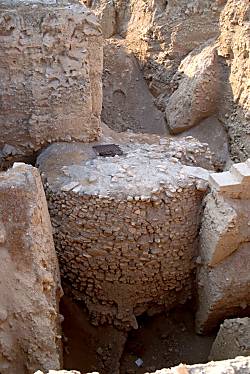
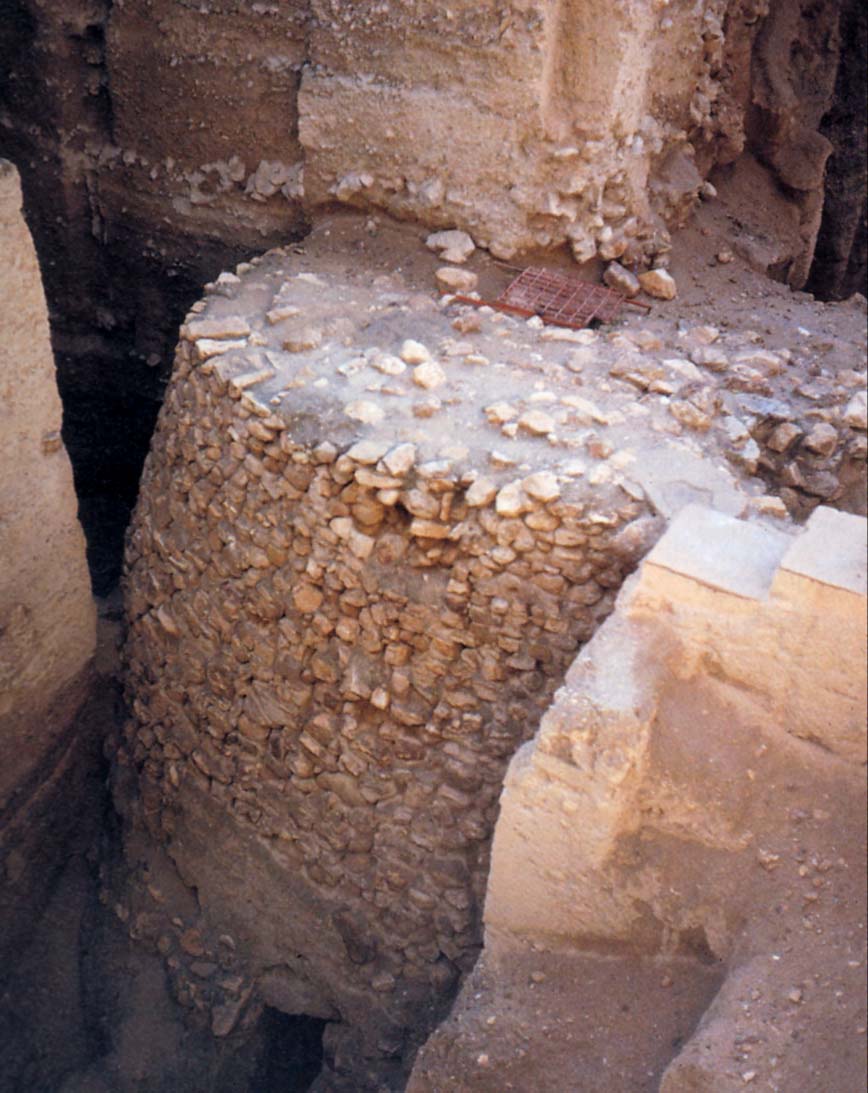
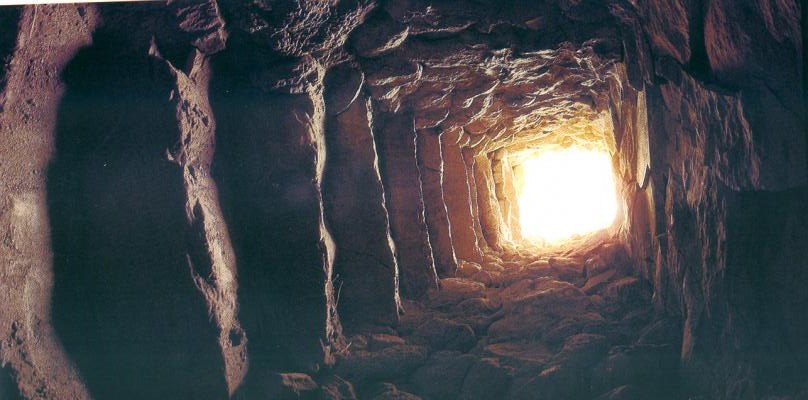 The PPNA town must eventually have needed to build defenses, and had someone who took charge and gave orders which others obeyed. A stone wall 6 to 12 feet high was built around the town, and a 30 foot high stone tower was built - just INSIDE the wall, not outside it. The tower was not hollow, but was filled with dirt except for a set of steps inside it leading to an entrance onto the top level of the tower. Some archaeologists describe this as a "defensive" tower, but I have my doubts - it seems to me more like a tower for enacting religious rituals or making proclamations to the city. It is inside the wall, so anyone trying to shoot arrows or throw rocks or atlatls from the top of it would have to throw them across the city wall rather than directly at an enemy. It faces the high cliffs to the west of the town, which are very difficult to climb; one would expect enemy armies to come across the Jordan from the east, or north-south along the valley of the Jordan. Whatever the tower was built for, it is a remarkable structure to have been built by people who did not read or write, who had no metal implements, and who had not yet invented pottery.
The PPNA town must eventually have needed to build defenses, and had someone who took charge and gave orders which others obeyed. A stone wall 6 to 12 feet high was built around the town, and a 30 foot high stone tower was built - just INSIDE the wall, not outside it. The tower was not hollow, but was filled with dirt except for a set of steps inside it leading to an entrance onto the top level of the tower. Some archaeologists describe this as a "defensive" tower, but I have my doubts - it seems to me more like a tower for enacting religious rituals or making proclamations to the city. It is inside the wall, so anyone trying to shoot arrows or throw rocks or atlatls from the top of it would have to throw them across the city wall rather than directly at an enemy. It faces the high cliffs to the west of the town, which are very difficult to climb; one would expect enemy armies to come across the Jordan from the east, or north-south along the valley of the Jordan. Whatever the tower was built for, it is a remarkable structure to have been built by people who did not read or write, who had no metal implements, and who had not yet invented pottery.
The PPNA period at Jericho seems to have lasted for about 1,000 years. From plant and animal remains, Dr. Kenyon concluded that food was produced by agriculture (varieties of grain) with meat supplied by hunting (mainly gazelles and foxes) rather than from domesticated animals. Towards the end of the PPNA period of occupation parts of the town wall collapsed and were not rebuilt. It is not clear what happened - a series of famines, earthquake, invading enemies, or the collapse of their system of irrigation - something caused the PPNA inhabitants to abandon the site.
7,500 - 6,000 BC - Pre-Pottery Neolithic B (PPNB)
- Jericho :
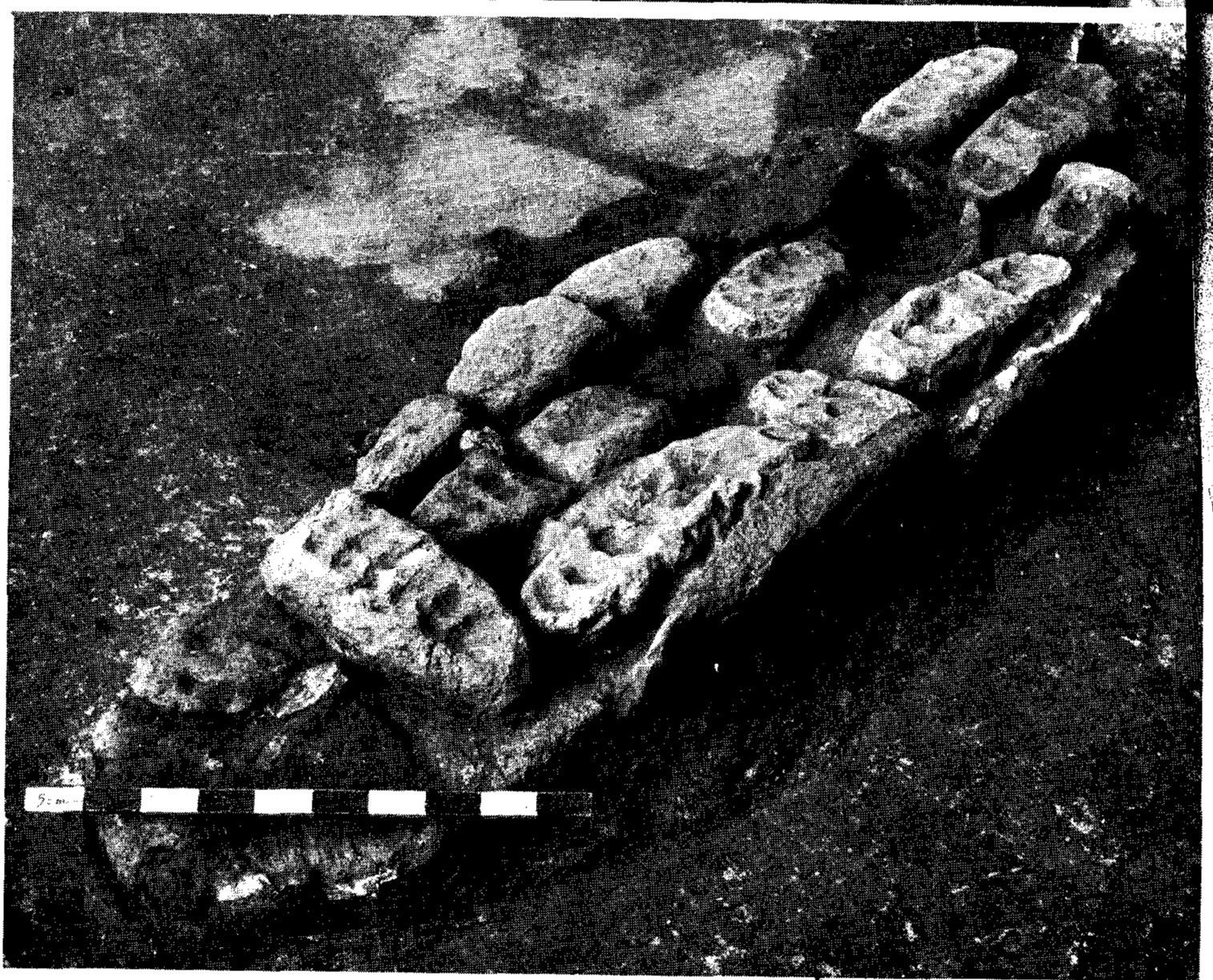
 Above the PPNA layers, the next layer of habitation, characterized as PPNB, gave evidence of a completely different culture - houses were rectilinear instead of round, and consisted of several rooms, surrounding a courtyard where cooking was carried out. They used plaster to finish the floors and walls, and also built plastered storage containers for rainwater. The flint and stone implements were different from those of the PPNA people. The bricks they made were slightly oval, marked on top with a pattern of thumbprints which gave a better key for the mortar when building a wall.
Above the PPNA layers, the next layer of habitation, characterized as PPNB, gave evidence of a completely different culture - houses were rectilinear instead of round, and consisted of several rooms, surrounding a courtyard where cooking was carried out. They used plaster to finish the floors and walls, and also built plastered storage containers for rainwater. The flint and stone implements were different from those of the PPNA people. The bricks they made were slightly oval, marked on top with a pattern of thumbprints which gave a better key for the mortar when building a wall.
The diet of the PPNB people differed from that of the PPNA - they still cultivated, harvested, and cooked grains (as indicated by flint blades for sickles, stone querns, pestles) but their meat supply included sheep and goats in addition to gazelles, so this was probably the beginning of the domestication of animals.
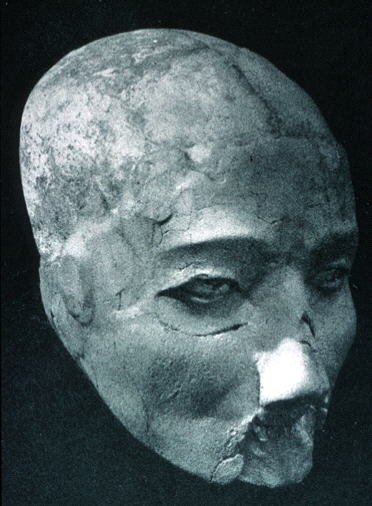
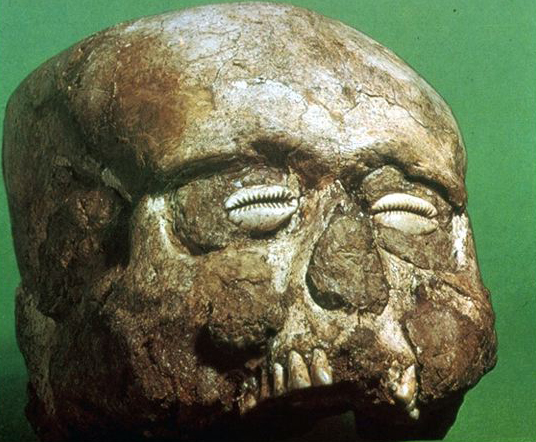
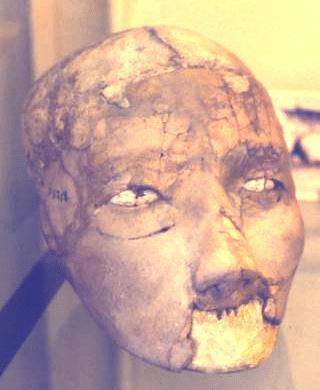
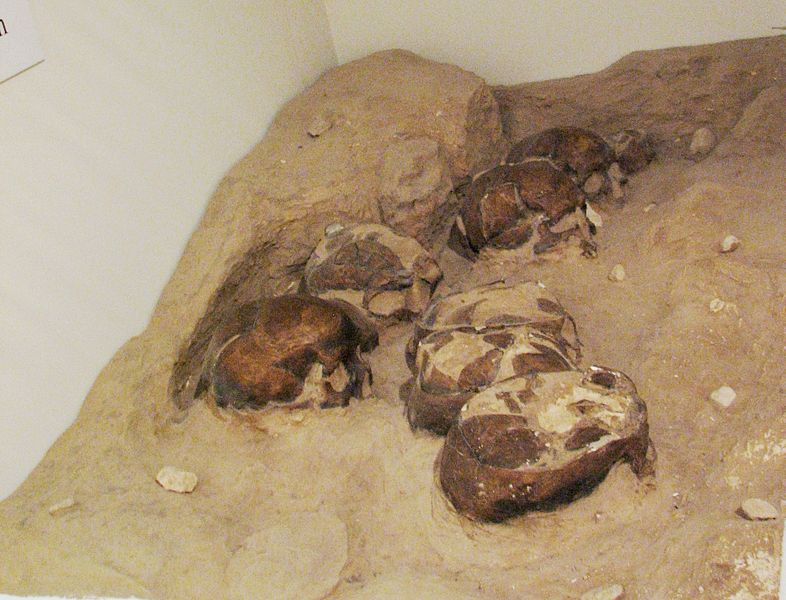 The PPNB culture shows spiritual, magic, or religious developments - little clay figures of animals, probable shrines, and the burials of plastered skulls under the floors of some houses.
The PPNB culture shows spiritual, magic, or religious developments - little clay figures of animals, probable shrines, and the burials of plastered skulls under the floors of some houses.
The PPNB culture was destroyed abruptly. There were some mass burials, and an indeterminate period of erosion and decay before a new group of people arrived - the Pottery Neolithic A people, who had discovered how to make pottery vessels. -

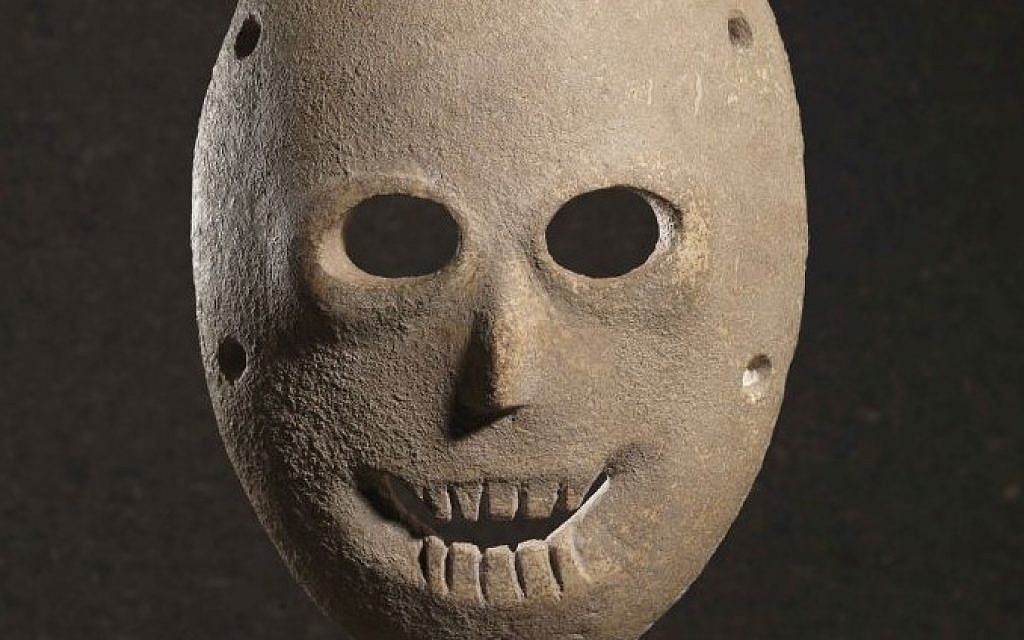 Nahal Hemar Cave in the Judean desert by the Dead Sea - contained a cache of Neolithic artefacts, including stone masks, beads, fragments of baskets and cloth, skulls, and the oldest known examples of glue
Nahal Hemar Cave in the Judean desert by the Dead Sea - contained a cache of Neolithic artefacts, including stone masks, beads, fragments of baskets and cloth, skulls, and the oldest known examples of glue
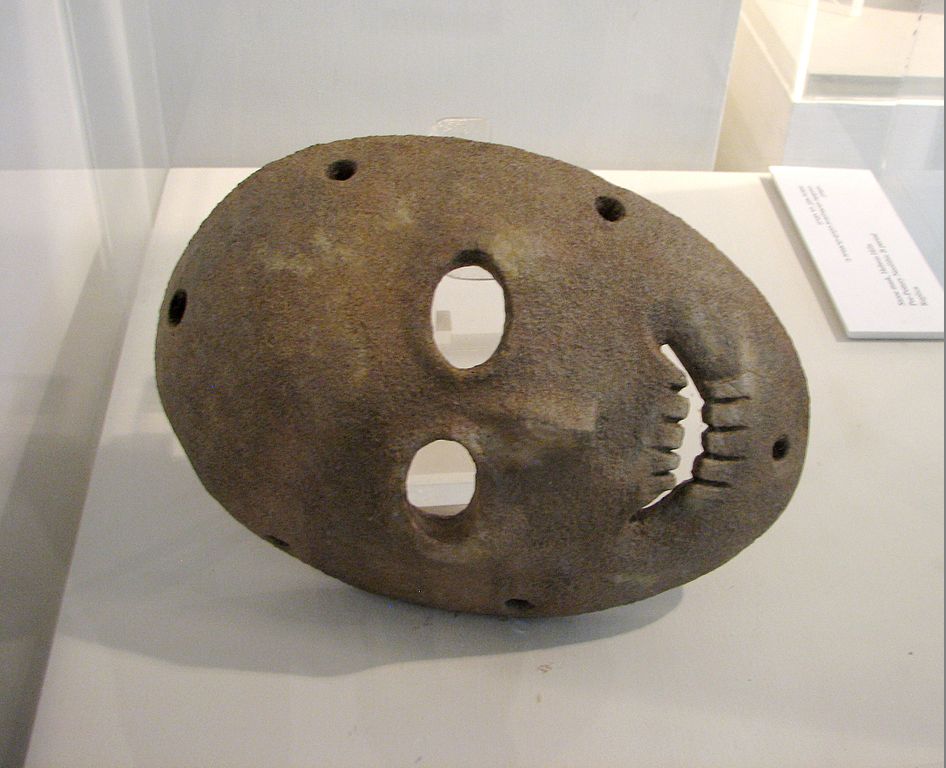
PPNB stone masks have also been found near Hebron -
Ain Ghazal in the northern Jordan valley, east of the Jordan,
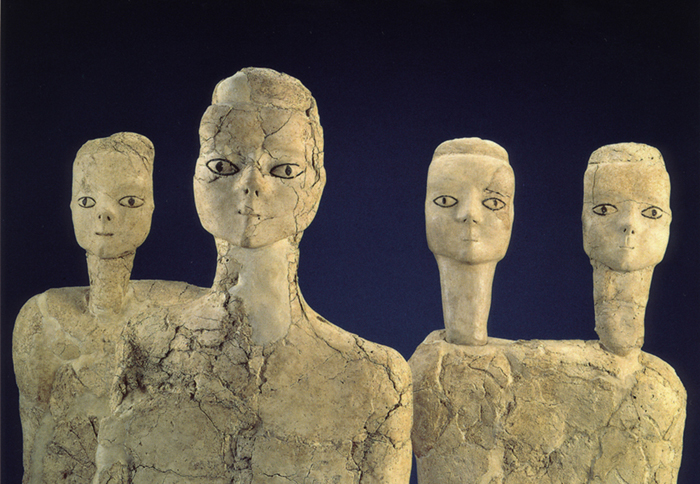
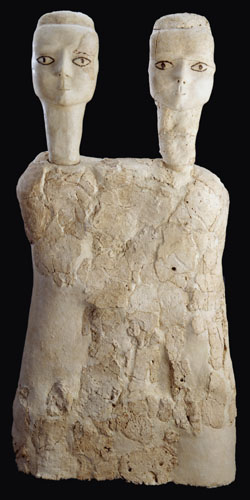


 was the site of a PPNB culture which not only modeled faces of clay on skulls, but also produced large colored figures made of clay plastered onto a frame of reeds and grass. Some archaeologists have suggested that this reflects a belief that human beings were created by being molded from clay (Genesis 2:7)
was the site of a PPNB culture which not only modeled faces of clay on skulls, but also produced large colored figures made of clay plastered onto a frame of reeds and grass. Some archaeologists have suggested that this reflects a belief that human beings were created by being molded from clay (Genesis 2:7)
6,000 - 4,300 BC : Pottery Neolithic (PN)
- Jericho - The Pottery Neolithic A people arrived at Jericho some time after the PPNB culture disappeared. The people of the PNA culture initially lived in pit-dwellings rather than houses. They had discovered how to make pottery vessels. They used different flint and stone implements which were generally not so well made as those of the preceding PPNB culture.
The site was then invaded or infiltrated by another group, the Pottery Neolithic B people who made much better pottery vessels than the PNA people, and who eventually started to build rectangular houses of rounded bricks (no thumb-prints), and later another wall round the town. -
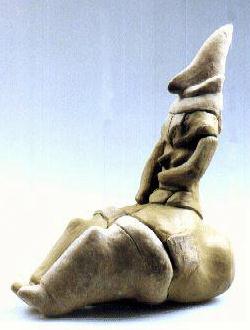
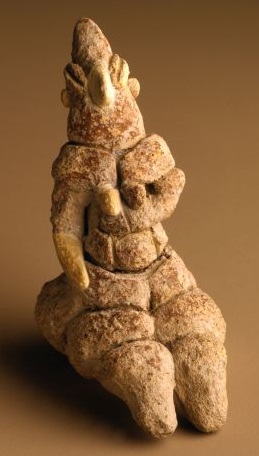
 The Yarmukian culture takes its name from the Yarmuk river. Major settlements have been found at Shaar Hagolan and Munhata,
The Yarmukian culture takes its name from the Yarmuk river. Major settlements have been found at Shaar Hagolan and Munhata,

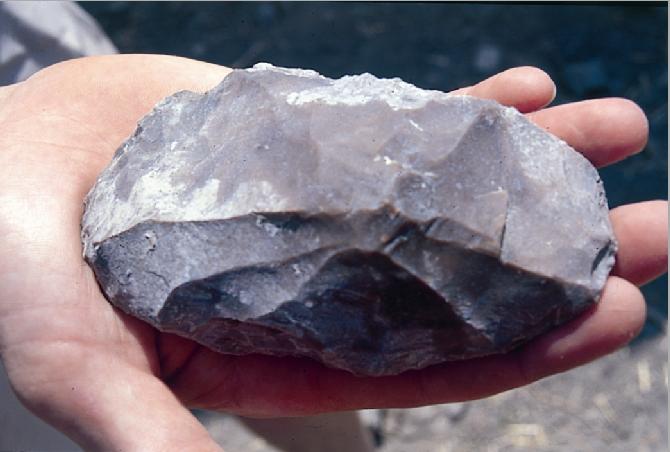 but the culture also spread through the Jezreel Valley to the Mediterranean coastal plain, and eastwards to Ain Ghazal. This culture is characterized by clay pottery figures of seated women with 'coffee-bean eyes'.
but the culture also spread through the Jezreel Valley to the Mediterranean coastal plain, and eastwards to Ain Ghazal. This culture is characterized by clay pottery figures of seated women with 'coffee-bean eyes'.
-
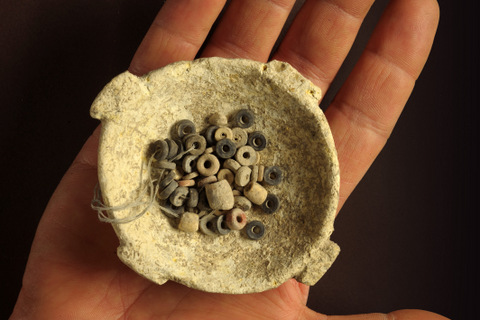 The Wadi Rabah culture takes its name from the site in the Shephalah, near the Mediterranean coast. This culture replaced the Yarmukian throughout the region of northern Palestine/Israel, and probably also into Syria and Lebanon. It was characterized by rectangular buildings with stone floors. The flint tools were mainly those used for agriculture, rather than hunting. Pottery was decorated with red, brown, or black slip, and was more varied than previously.
The Wadi Rabah culture takes its name from the site in the Shephalah, near the Mediterranean coast. This culture replaced the Yarmukian throughout the region of northern Palestine/Israel, and probably also into Syria and Lebanon. It was characterized by rectangular buildings with stone floors. The flint tools were mainly those used for agriculture, rather than hunting. Pottery was decorated with red, brown, or black slip, and was more varied than previously.
Of indeterminate date
-
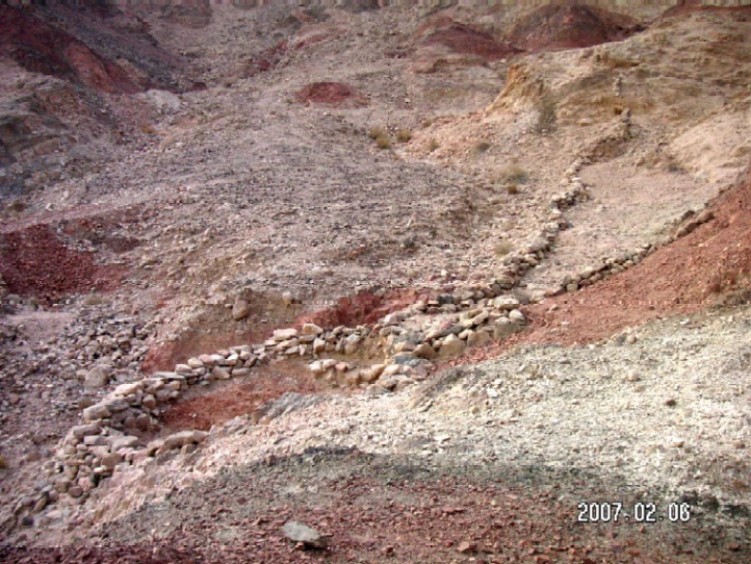
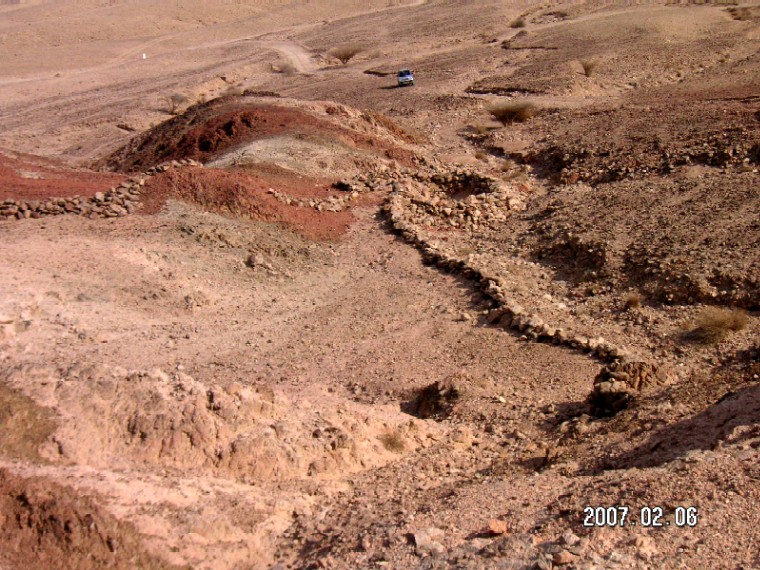 The Neolithic Desert kites are evidence for a continuing population of hunters in the arid regions of the Negev, Sinai, Transjordan, and Syria.
The Neolithic Desert kites are evidence for a continuing population of hunters in the arid regions of the Negev, Sinai, Transjordan, and Syria.
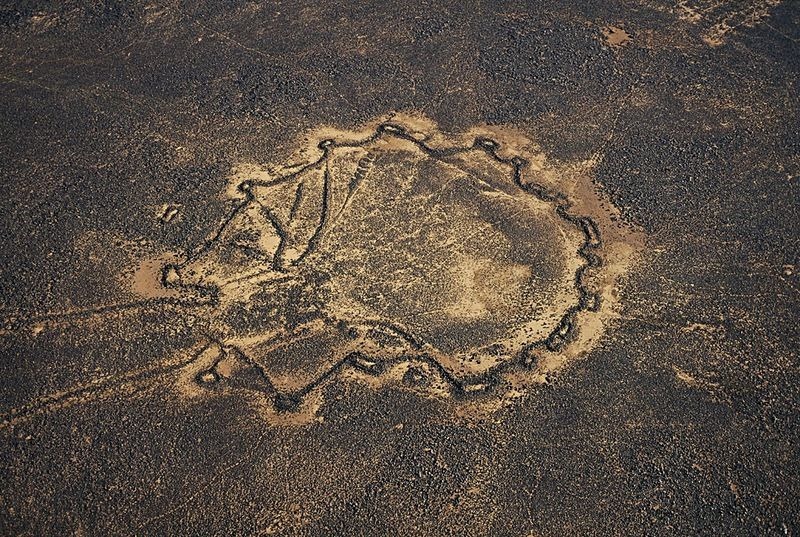
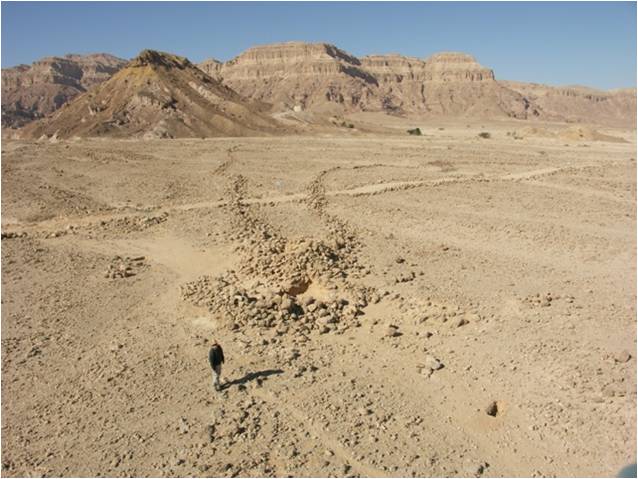 These sites are difficult to date, because they consist of surface remains. with no strata below or above them. They consist of dry stone walls (no mortar), often extending for several miles and reaching up to five feet high; the walls lead to a roughly circular enclosure where two walls meet. Although portions of the walls were known and described during the early twentieth century (e.g. by T. E. Lawrence in 1912) their frequency, pattern, and purpose were not understood until they were identified from the air during the 1920s. It is thought that they were used for driving animals into the enclosure, where they could be killed. Bones of gazelles and other wild animals have been found at the sites. Mazar speculates that there may have been rivalry between the desert dwellers and the urban cultures, and that this relationship continued throughout the history of the ancient Near East (see Genesis 25:27-28)
These sites are difficult to date, because they consist of surface remains. with no strata below or above them. They consist of dry stone walls (no mortar), often extending for several miles and reaching up to five feet high; the walls lead to a roughly circular enclosure where two walls meet. Although portions of the walls were known and described during the early twentieth century (e.g. by T. E. Lawrence in 1912) their frequency, pattern, and purpose were not understood until they were identified from the air during the 1920s. It is thought that they were used for driving animals into the enclosure, where they could be killed. Bones of gazelles and other wild animals have been found at the sites. Mazar speculates that there may have been rivalry between the desert dwellers and the urban cultures, and that this relationship continued throughout the history of the ancient Near East (see Genesis 25:27-28)
Copyright © 1999 Shirley J. Rollinson, all Rights Reserved